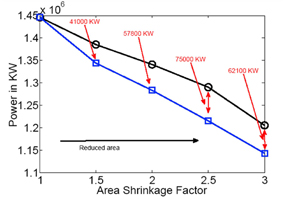Techniques for Addressing Larger Wind Farms
 Layout tools attempt to identify the best layout of wind turbines on a land or offshore area according to energy capture. They model free stream wind flowing through an area with sited turbines and calculate the energy output of successive turbines while taking wake effects and turbulence intensities into account. A key component of such tools is the ‘optimiser’ algorithm used to efficiently search through a modest proportion of candidate layouts to identify the best one. This article discusses earlier bio-inspired algorithms, and then the CMA-ES algorithm, an evolutionary algorithm that performs stochastic sampling optimisation by mimicking fundamental aspects of the neo-Darwinian evolutionary process.
Layout tools attempt to identify the best layout of wind turbines on a land or offshore area according to energy capture. They model free stream wind flowing through an area with sited turbines and calculate the energy output of successive turbines while taking wake effects and turbulence intensities into account. A key component of such tools is the ‘optimiser’ algorithm used to efficiently search through a modest proportion of candidate layouts to identify the best one. This article discusses earlier bio-inspired algorithms, and then the CMA-ES algorithm, an evolutionary algorithm that performs stochastic sampling optimisation by mimicking fundamental aspects of the neo-Darwinian evolutionary process.
By Kalyan Veeramachaneni and Una-May O’Reilly, Evolutionary Design and Optimization Group, CSAIL, MIT, USA
 Layout tools attempt to identify the best layout of wind turbines on a land or offshore area according to energy capture. They model free stream wind flowing through an area with sited turbines and calculate the energy output of successive turbines while taking wake effects and turbulence intensities into account. A key component of such tools is the ‘optimiser’ algorithm used to efficiently search through a modest proportion of candidate layouts to identify the best one. This article discusses earlier bio-inspired algorithms, and then the CMA-ES algorithm, an evolutionary algorithm that performs stochastic sampling optimisation by mimicking fundamental aspects of the neo-Darwinian evolutionary process.
Layout tools attempt to identify the best layout of wind turbines on a land or offshore area according to energy capture. They model free stream wind flowing through an area with sited turbines and calculate the energy output of successive turbines while taking wake effects and turbulence intensities into account. A key component of such tools is the ‘optimiser’ algorithm used to efficiently search through a modest proportion of candidate layouts to identify the best one. This article discusses earlier bio-inspired algorithms, and then the CMA-ES algorithm, an evolutionary algorithm that performs stochastic sampling optimisation by mimicking fundamental aspects of the neo-Darwinian evolutionary process.By Kalyan Veeramachaneni and Una-May O’Reilly, Evolutionary Design and Optimization Group, CSAIL, MIT, USA










